Thermal Decomposition Path—Studied by the Simultaneous Thermogravimetry Coupled with Fourier Transform Infrared Spectroscopy and Quadrupole Mass Spectrometry—Of Imidazoline/Dimethyl Succinate Hybrids and Their Biological Characterization
Abstract
:1. Introduction
2. Materials and Methods
2.1. Chemicals and Instruments
2.2. The Investigated Compounds (1–5)
2.3. Differential Scanning Calorimetry (DSC)
2.4. Simultaneous Thermogravimetric Analysis Coupled On-Line with FTIR and QMS Analyzers (TG/DTG/FTIR/QMS)
2.5. An Assessment of the Anticancer Activity and Toxicity for Normal Cells of the Tested Compounds
2.6. Study of the Effect of the Investigated Compounds on Red Blood Cells
3. Results and Discussion
3.1. Melting Temperatures of the Tested Compounds
3.2. Thermal Stability of the Tested Compounds (Inert Conditions)
3.3. Thermal Stability of the Tested Compounds (Oxidizing Conditions)
3.4. Decomposition Course of the Tested Compounds (Inert Conditions)
3.5. Decomposition Course of the Tested Compounds (Oxidizing Conditions)
3.6. Antitumor Activity and Cytotoxicity to Normal Cells of the Investigated Compounds
3.7. Assessment of the Effect of the Tested Compounds (1–5) on Red Blood Cells
3.8. Predicting Molecular Targets for the Investigated Compounds (1–5)
4. Conclusions
Author Contributions
Funding
Institutional Review Board Statement
Informed Consent Statement
Data Availability Statement
Conflicts of Interest
References
- Sztanke, K.; Tkaczyński, T. Preparation of New Dimethyl Esters of 2-[(1-aryl-Δ2-imidazolin-2-ylhydrazono]succinic Acids. Polish Patent 188616, 31 March 2005. [Google Scholar]
- Sztanke, M.; Tuzimski, T.; Janicka, M.; Sztanke, K. Structure-retention behaviour of biologically active fused 1,2,4-triazinones—Correlation with in silico molecular properties. Eur. J. Pharm. Sci. 2015, 68, 114–126. [Google Scholar] [CrossRef] [PubMed]
- Sztanke, M.; Sztanke, K. Biologically important hydrazide-containing fused azaisocytosines as antioxidant agents. Redox Rep. 2017, 22, 572–581. [Google Scholar] [CrossRef] [PubMed] [Green Version]
- Caires, C.F.J.; Lima, L.S.; Carvalho, C.T.; Ionashiro, M. Thermal behaviour of succinic acid, sodium succinate and its compounds with some bivalent transitions metal ions in dynamic N2 and CO2 atmospheres. Eclética Química São Paulo 2010, 35, 73–80. [Google Scholar] [CrossRef]
- Caires, C.F.J.; Lima, L.S.; Carvalho, C.T.; Ionashiro, M. Thermal behaviour of succinic acid, sodium succinate and its compounds with some bivalent transition metal ions. Thermochim. Acta 2010, 500, 6–12. [Google Scholar] [CrossRef]
- Mihovec, K.; Temova Rakuša, Ž.; Gaál, E.É.; Roškar, R. Evaluation of the stability of hydrocortisone sodium succinate in solutions for parenteral use by a validated HPLC-UV method. Acta Chim. Slov. 2022, 8, 7539. [Google Scholar] [CrossRef]
- Trissel, L.A.; Zhang, Y. Stability of methylprednisolone sodium succinate in autodose infusion system bags. J. Am. Pharm. Assoc. 2002, 42, 868–870. [Google Scholar] [CrossRef]
- Ghabbour, H.A.; Bakheit, A.H.; Ezzeldin, E.; Mostafa, G.A.E. Synthesis Characterization and X-ray Structure of 2-(2,6-Dichlorophenylamino)-2-imidazoline Tetraphenylborate: Computational Study. Appl. Sci. 2022, 12, 3568. [Google Scholar] [CrossRef]
- Legendre, B.; Baziard-Mouysset, G.; Anastassiadou, M.; Leger, J.M.; Payard, M. Polymorphic study of 2-(2-benzofuryl) Δ-2 imidazoline. J. Therm. Anal. Calorim. 2001, 66, 659–673. [Google Scholar] [CrossRef]
- Marciniec, B.; Kozak, M.; Naskrent, M.; Dettlaff, K.; Ogrodowczyk, M.; Stawny, M.; Wachowski, L. Thermal study of four irradiated imidazoline derivatives in solid state. J. Therm. Anal. Calorim. 2007, 88, 337–342. [Google Scholar] [CrossRef] [Green Version]
- Wesolowski, M.; Leyk, E. Coupled and Simultaneous Thermal Analysis Techniques in the Study of Pharmaceuticals. Pharmaceutics 2023, 15, 1596. [Google Scholar] [CrossRef]
- Saber, R.A.; Attia, A.K.; Salem, W.M. Thermal analysis study of antihypertensive drugs telmisartan and cilazapril. Adv. Pharm. Bull. 2014, 4, 283–287. [Google Scholar]
- Attia, A.K.; Abdel-Moety, M.M.; Abdel-Hamid, S.G. Thermal analysis study of antihypertensive drug doxazosin mesilate. Arab. J. Chem. 2017, 10, S334–S338. [Google Scholar] [CrossRef] [Green Version]
- Ledeti, A.; Olariu, T.; Caunii, A.; Vlase, G.; Circioban, D.; Baul, B.; Ledeti, I.; Vlase, T.; Murariu, M. Evaluation of thermal stability and kinetic of degradation for levodopa in non-isothermal conditions. J. Therm. Anal. Calorim. 2018, 131, 1881–1888. [Google Scholar] [CrossRef]
- Hsieh, W.-H.; Cheng, W.-T.; Chen, L.-C.; Lin, S.-Y. Non-isothermal dehydration kinetic study of aspartame hemihydrate using DSC, TGA and DSC-FTIR microspectroscopy. Asian J. Pharm. Sci. 2018, 13, 212–219. [Google Scholar] [CrossRef] [PubMed]
- Luis, C.H.; German, M.R.; Rolando, V.Z.; Gustavo, C.B. Combined use of DSC, TGA, XDR and NIR in the compatibility study of preformulation mixtures for the development of 10 mg tablets of rupatadine fumarate. J. Drug Deliv. Ther. 2018, 8, 42–54. [Google Scholar] [CrossRef]
- Sangeetha Margreat, S.; Ramalingam, S.; Sebastian, S.; Xavier, S.; Periandy, S.; Daniel, J.C.; Maria Julie, M. DFT, spectroscopic, DSC/TGA, electronic, biological and molecular docking investigation of 2,5-thiophenedicarboxylic acid: A promising anticancer agent. J. Mol. Struct. 2020, 1200, 127099. [Google Scholar] [CrossRef]
- Sztanke, M.; Rzymowska, J.; Sztanke, K. Synthesis, structure elucidation and in vitro anticancer activities of novel derivatives of diethyl (2E)-2-[(2E)-(1-arylimidazolidin-2-ylidene)hydrazono]succinate and ethyl (4-oxo-8-aryl-4,6,7,8-tetrahydroimidazo[2,1-c][1,2,4]triazin-3-yl)acetate. Bioorg. Med. Chem. 2013, 21, 7465–7480. [Google Scholar] [CrossRef]
- Khodja, I.A.; Bensouici, C.; Boulebd, H. Combined experimental and theoretical studies of the structure-antiradical activity relationship of heterocyclic hydrazone compounds. J. Mol. Struct. 2020, 1221, 128858. [Google Scholar] [CrossRef]
- Sztanke, K.; Tkaczyński, T. Synthesis of new derivatives of dimethyl 2-(1-phenyl-Δ2-imidazolin-2-ylhydrazono)succinate. Acta Pol. Pharm.-Drug Res. 1997, 54, 389–392. [Google Scholar]
- Sztanke, M.; Rzymowska, J.; Sztanke, K. Synthesis, structure elucidation and identification of antiproliferative activities of a novel class of thiophene bioisosteres bearing the privileged 7,8-dihydroimidazo[2,1-c][1,2,4]triazin-4(6H)-one scaffold. Bioorg. Med. Chem. 2015, 23, 3448–3456. [Google Scholar] [CrossRef]
- Ostasz, A.; Łyszczek, R.; Sztanke, K.; Sztanke, M. TG-DSC and TG-FTIR Studies of Annelated Triazinylacetic Acid Ethyl Esters–Potential Anticancer Agents. Molecules 2023, 28, 1735. [Google Scholar] [CrossRef] [PubMed]
- Le Count, D.J.; Greer, A.T. Cyclisation of heterocyclic hydrazones prepared from dimethyl acetylenedicarboxylate. J. Chem. Soc. Perkin Trans. 1974, 1, 297–301. [Google Scholar] [CrossRef]
- Shamsipur, M.; Pourmortazavi, S.M.; Beigi, A.A.M.; Heydari, R.; Khatibi, M. Thermal stability and decomposition kinetic studies of acyclovir and zidovudine drug compounds. AAPS PharmSciTech 2013, 14, 287–293. [Google Scholar] [CrossRef] [PubMed] [Green Version]
- Yoshida, M.I.; Gomes, E.C.; Soares, C.D.; Oliveira, M.A. Thermal behavior study and decomposition kinetics of amiodarone hydrochloride under isothermal conditions. Drug Dev. Ind. Pharm. 2011, 37, 638–647. [Google Scholar] [CrossRef] [PubMed]
- NIST Chemistry Webbook. NIST Standard Reference Data. 2011. Available online: http://webbook.nist.gov (accessed on 1 June 2023).
- Bartyzel, A.; Sztanke, M.; Sztanke, K. Thermal behaviour of antiproliferative active 3-(2-furanyl)-8-aryl-7,8-dihydroimidazo[2,1-c][1,2,4]triazin-4(6H)-ones. J. Therm. Anal. Calorim. 2017, 130, 1541–1551. [Google Scholar] [CrossRef] [Green Version]
- Sikorska-Iwan, M.; Mrozek-Łyszczek, R. Application of coupled TG-FTIR system in studies of thermal stability of manganese(II) complexes with amino acids. J. Therm. Anal. Calorim. 2004, 78, 487–500. [Google Scholar] [CrossRef]
- NIST MS Search Program; version 2.0; for the 2014 Version of the NIST/EPA/NIH Mass Spectral Library; NIST: Gaithersburg, MD, USA, 2014.
- Koltsov, I. Thermal stability of polymeric carbon nitride (PCN)-Al2O3–ZrO2 nanocomposites used in photocatalysis. J. Therm. Anal. Calorim. 2022, 147, 7675–7682. [Google Scholar] [CrossRef]
- Rotival, C.; Renacco, E.; Arfi, C.; Pauli, A.M.; Pastor, J. Gases emitted during thermal decomposition of a polypropylene film and a polyurethane adhesive. J. Therm. Anal. 1994, 41, 1519–1527. [Google Scholar] [CrossRef]
- Materazzi, S.; Vecchio, S. Recent applications of evolved gas analysis by infrared spectroscopy (IR-EGA). Appl. Spectrosc. Rev. 2013, 48, 654–689. [Google Scholar] [CrossRef]
- Park, K.-B.; Kim, J.-S. Pyrolysis products from various types of plastics using TG-FTIR at different reaction temperatures. J. Anal. Appl. Pyrolysis 2023, 171, 105983. [Google Scholar] [CrossRef]
- Huang, Y.; Sekyere, D.T.; Zhang, J.; Tian, Y. Fast pyrolysis behaviors of biomass with high contents of ash and nitrogen using TG-FTIR and Py-GC/MS. J. Anal. Appl. Pyrolysis 2023, 170, 105922. [Google Scholar] [CrossRef]
- Liu, Y.; Yang, L.; Ma, C.; Zhang, Y. Thermal behavior of sweet potato starch by non-isothermal thermogravimetric analysis. Materials 2019, 12, 699. [Google Scholar] [CrossRef] [PubMed] [Green Version]
- Lehmann, W.D.; Bohne, A.; von der Lieth, C.-W. The information encrypted in accurate peptide masses—improved protein identification and assistance in glycopeptide identification and characterization. J. Mass Spectrom. 2000, 35, 1335–1341. [Google Scholar] [CrossRef] [PubMed]
- Hussein, Y.T.; Azeez, Y.H. DFT analysis and in silico exploration of drug-likeness, toxicity prediction, bioactivity score, and chemical reactivity properties of the urolithins. J. Biomol. Struct. Dyn. 2023, 41, 1168–1177. [Google Scholar] [CrossRef]
- Jeelani, A.; Muthu, S.; Narayana, B. Molecular structure determination, bioactivity score, spectroscopic and quantum computational studies on (E)-N′-(4-chlorobenzylidene)-2-(napthalen-2-yloxy) acetohydrazide. J. Mol. Struct. 2021, 1241, 130558. [Google Scholar] [CrossRef]
- Flores-Holguín, N.; Frau, J.; Glossman-Mitnik, D. Chemical Reactivity Properties and Bioactivity Scores of the Angiotensin II Vasoconstrictor Octapeptide. In Cheminformatics and Its Applications; IntechOpen: London, UK, 2020. [Google Scholar]
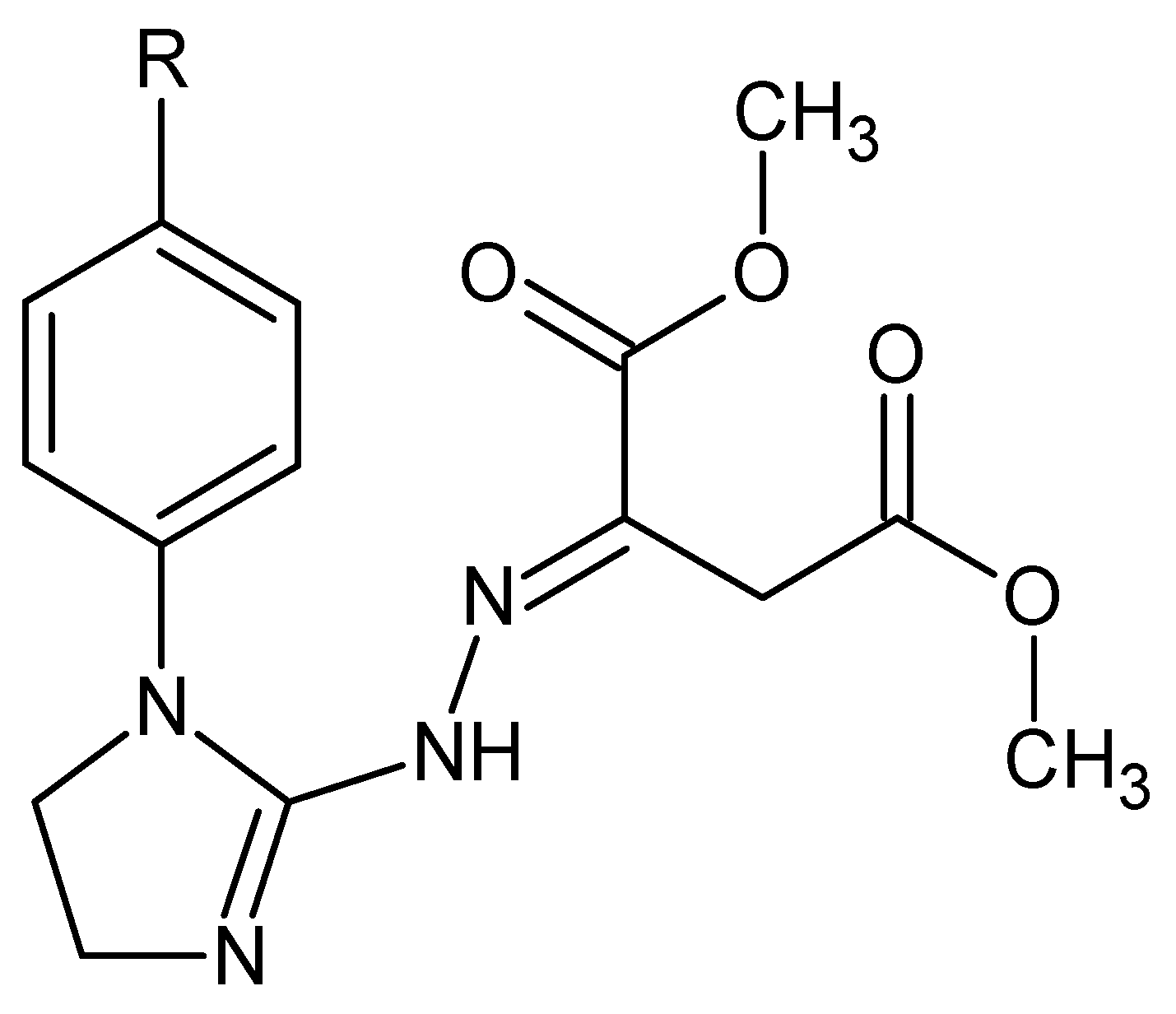
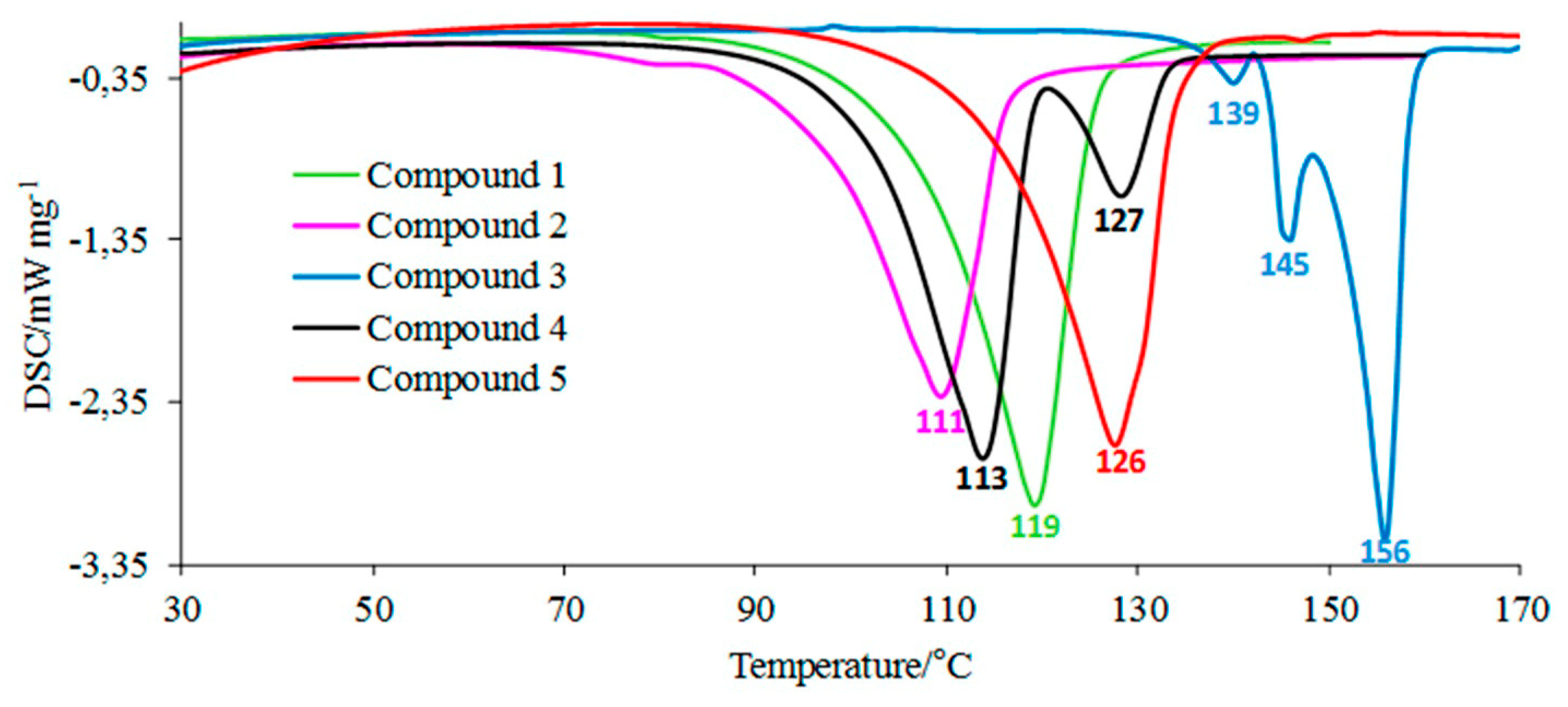

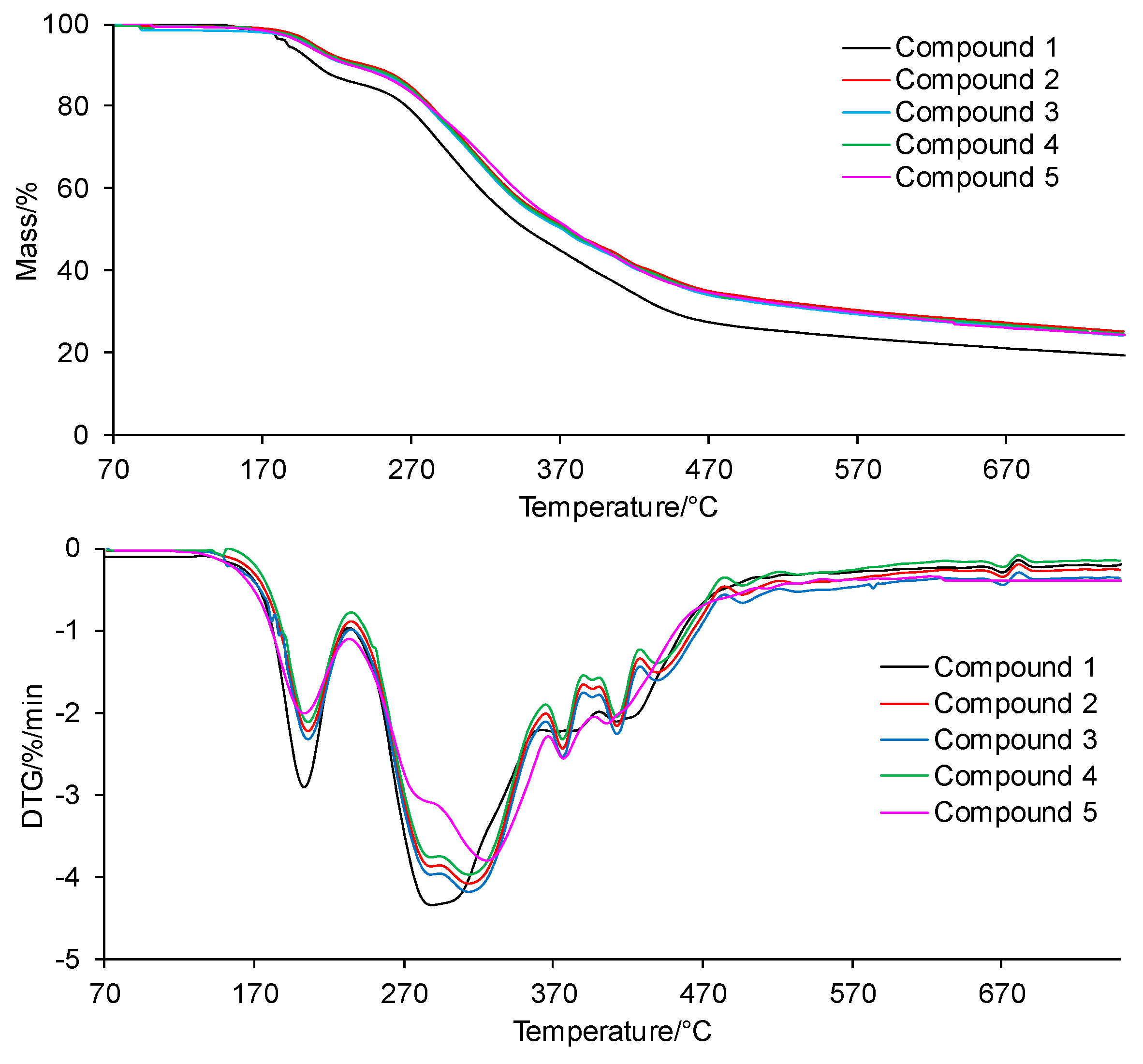

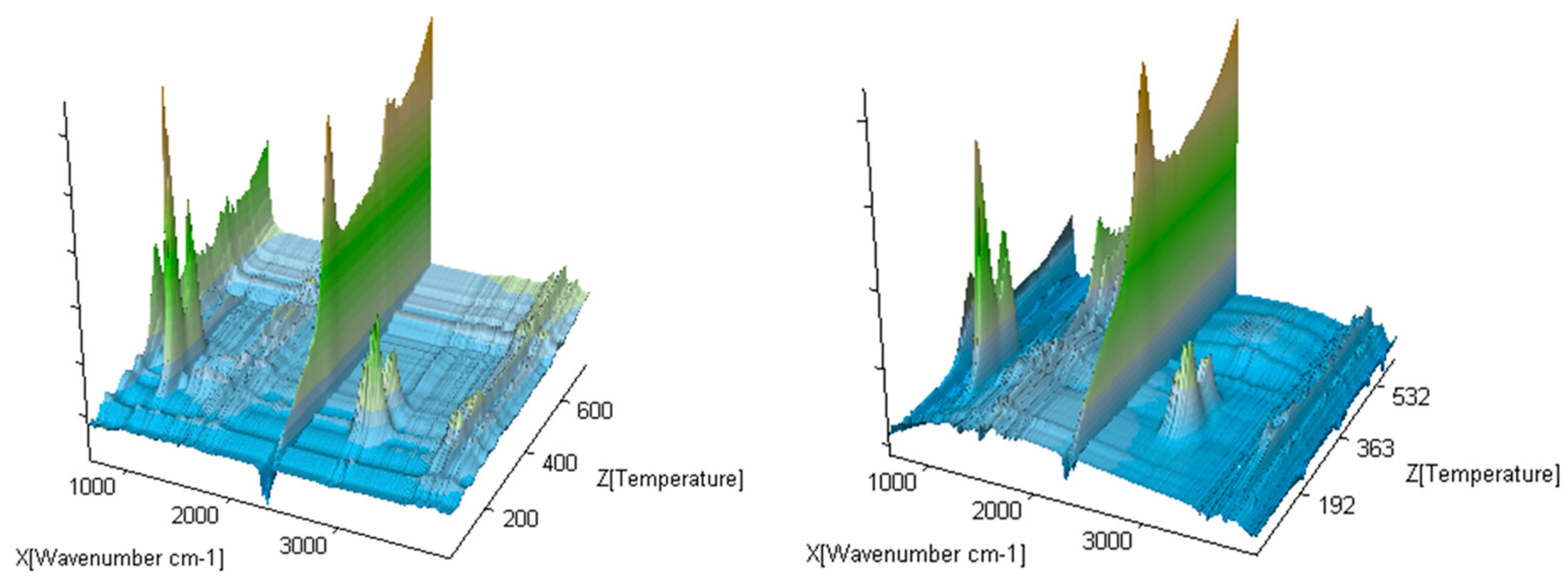


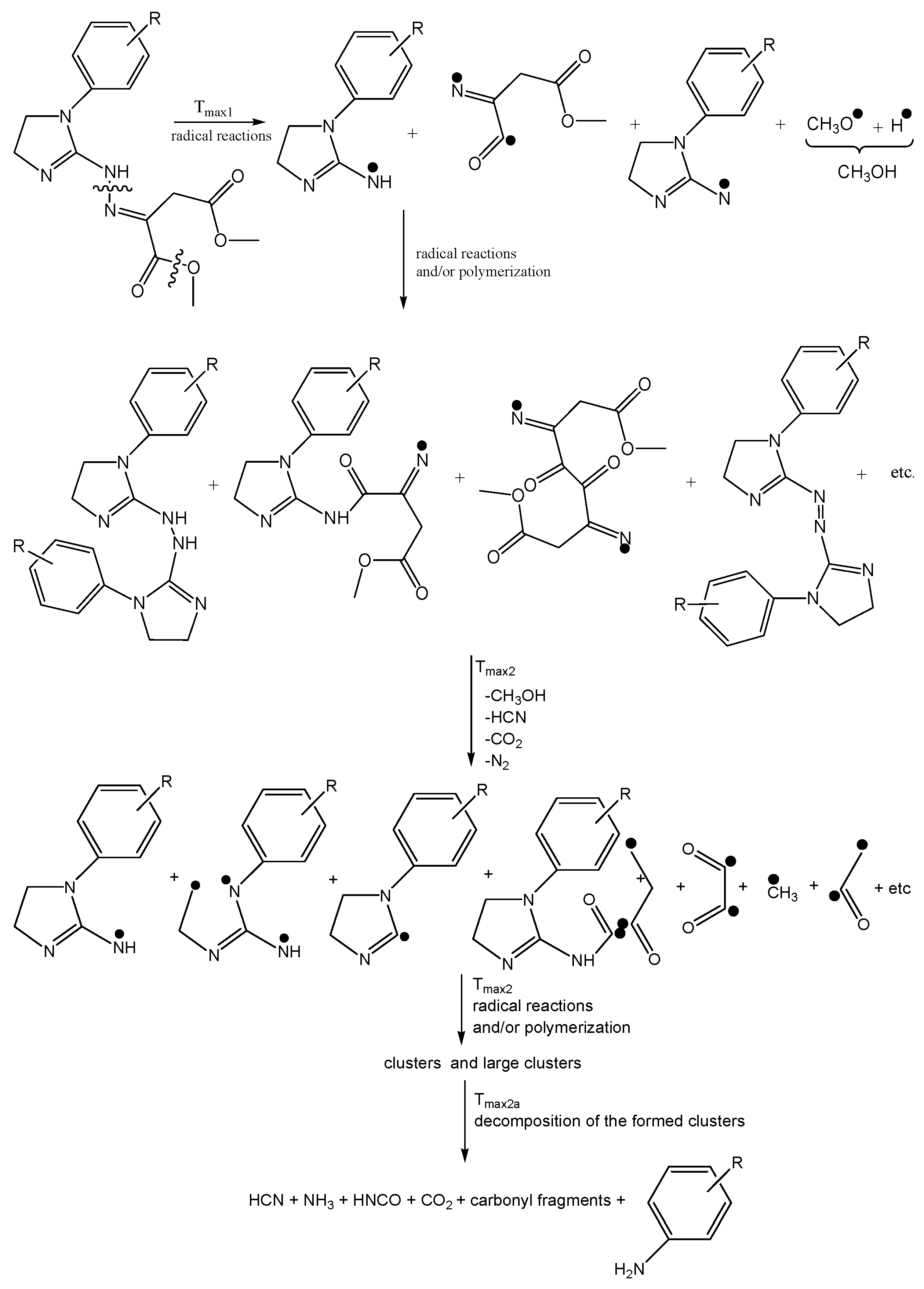
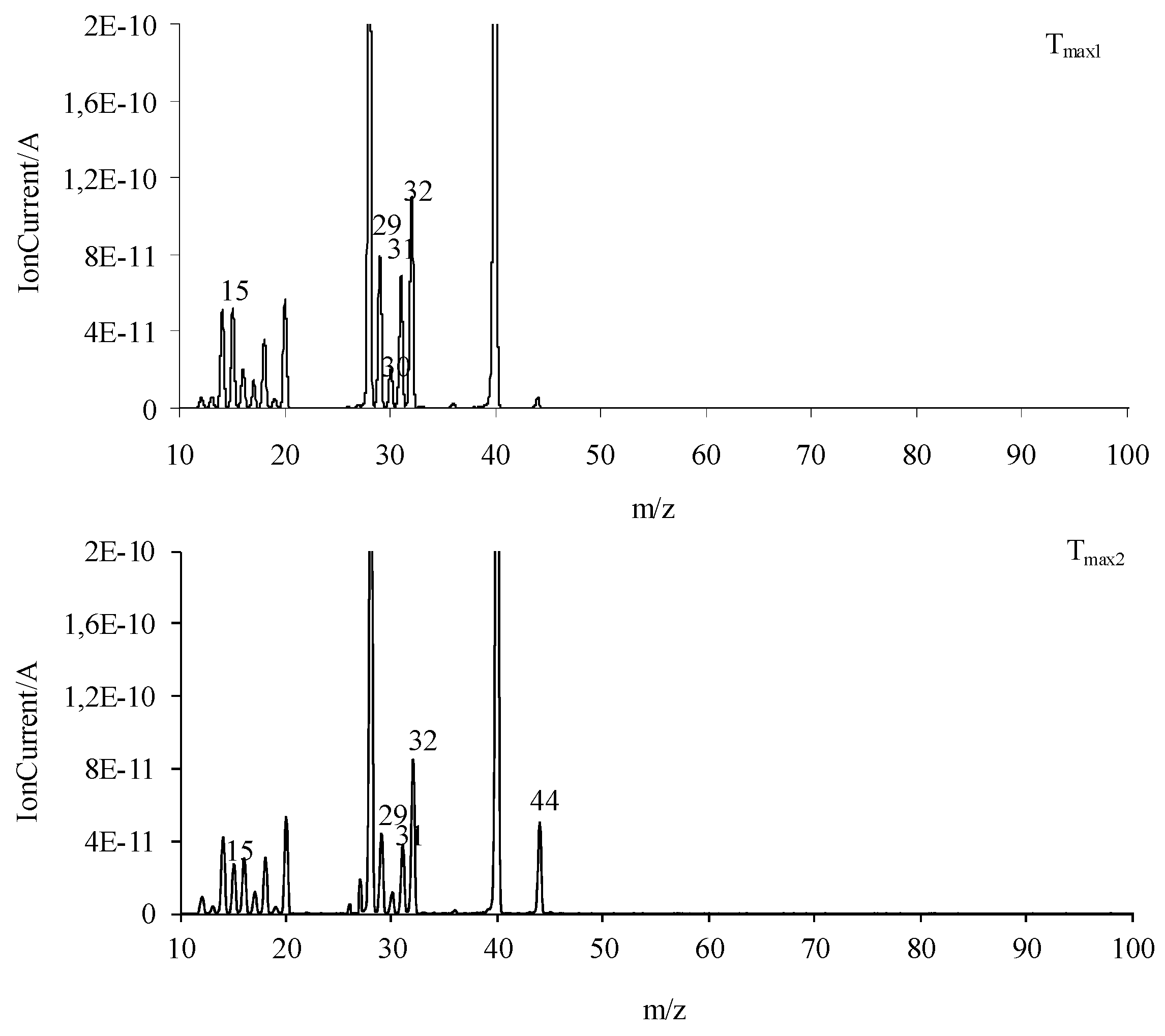
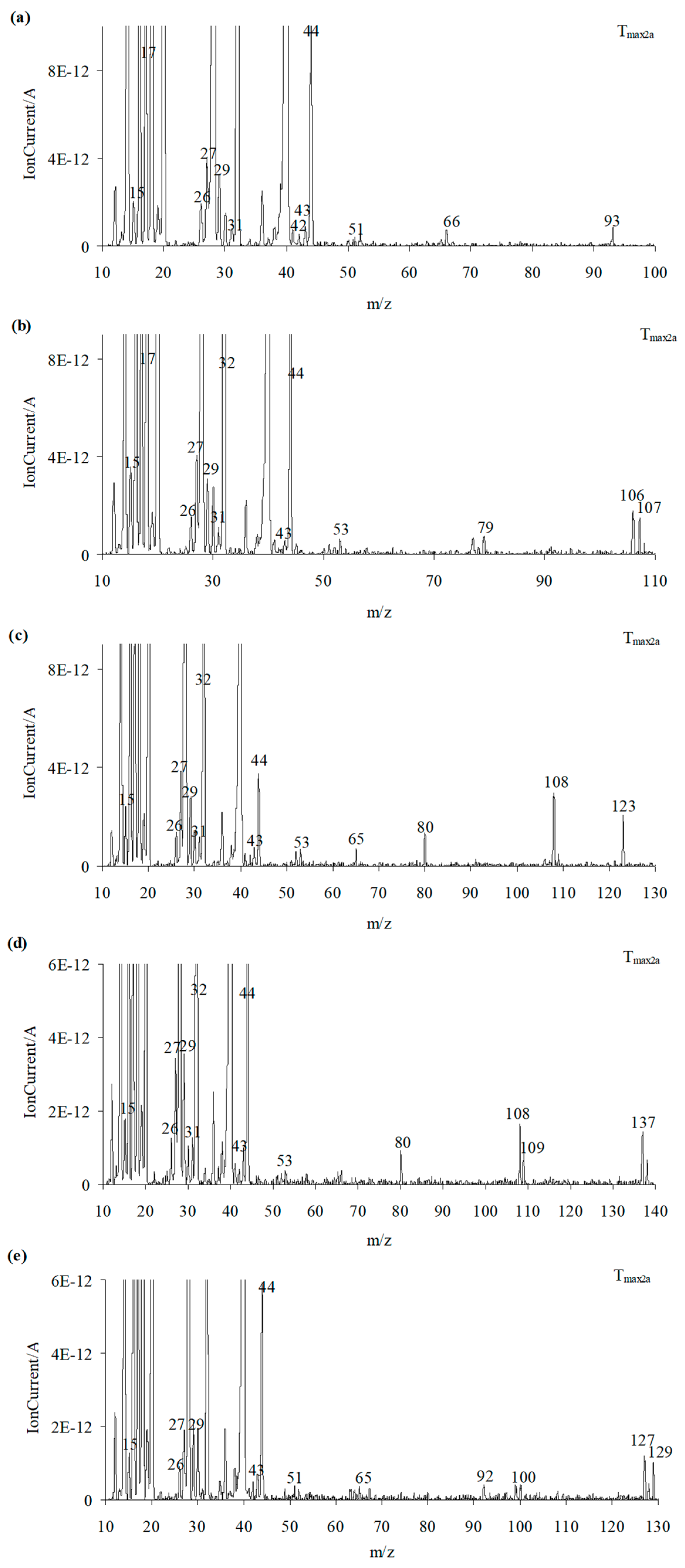
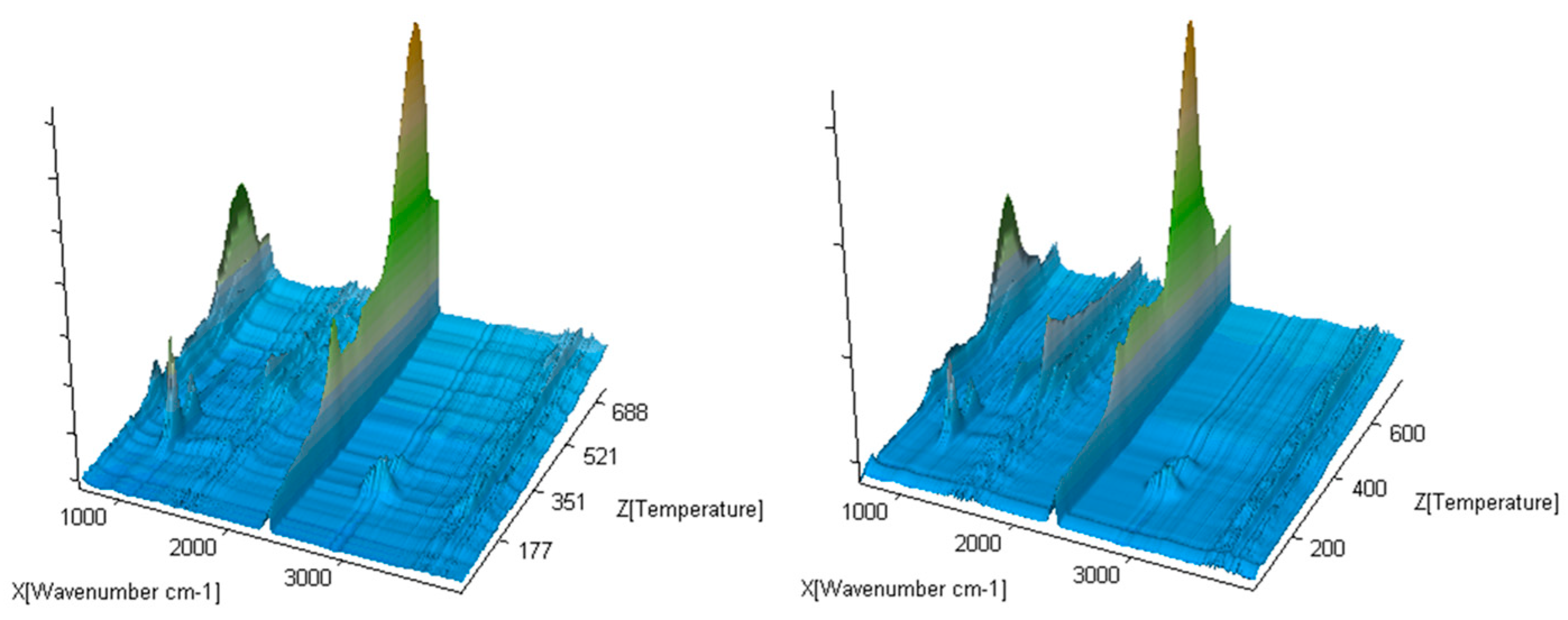
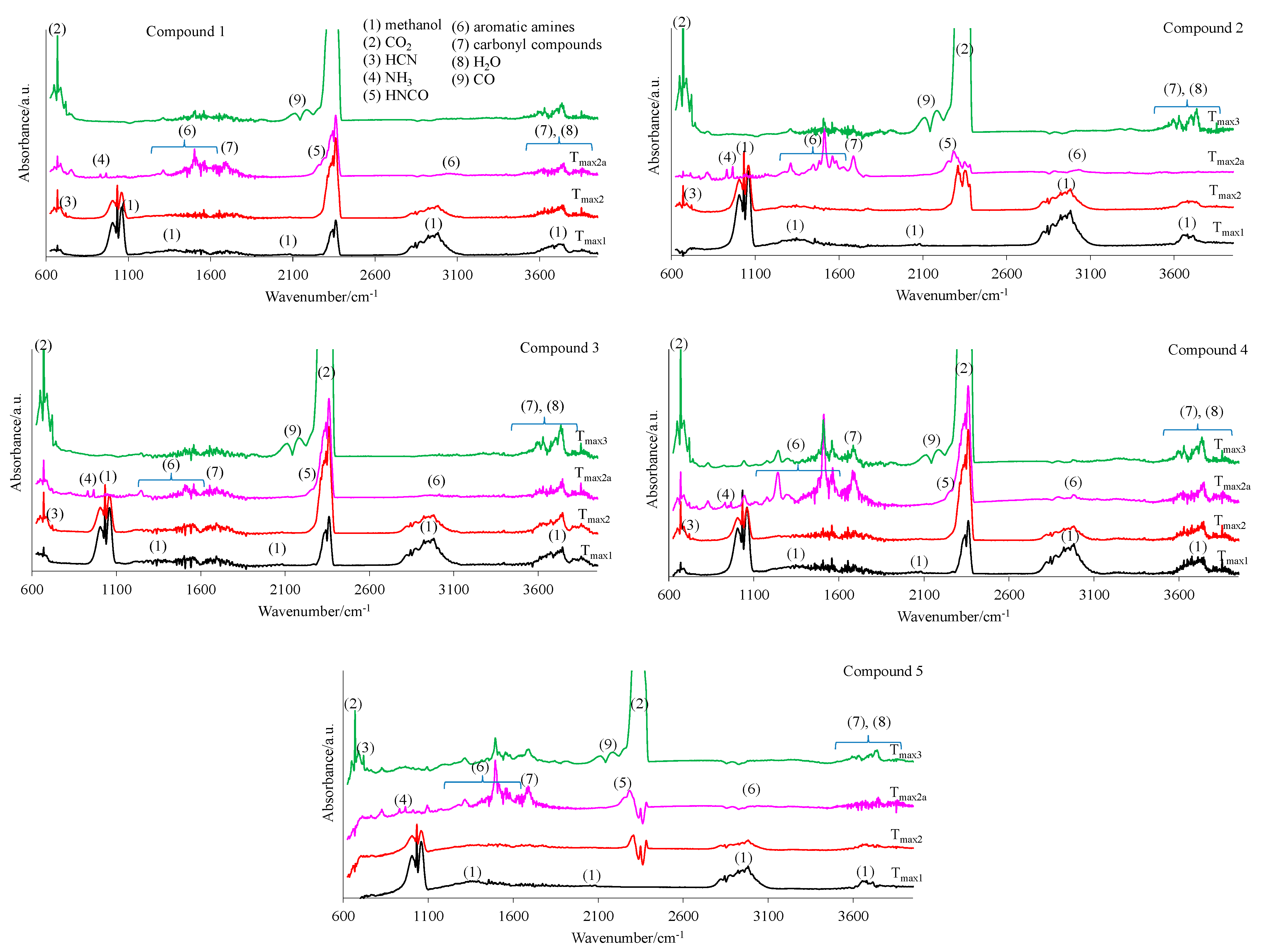
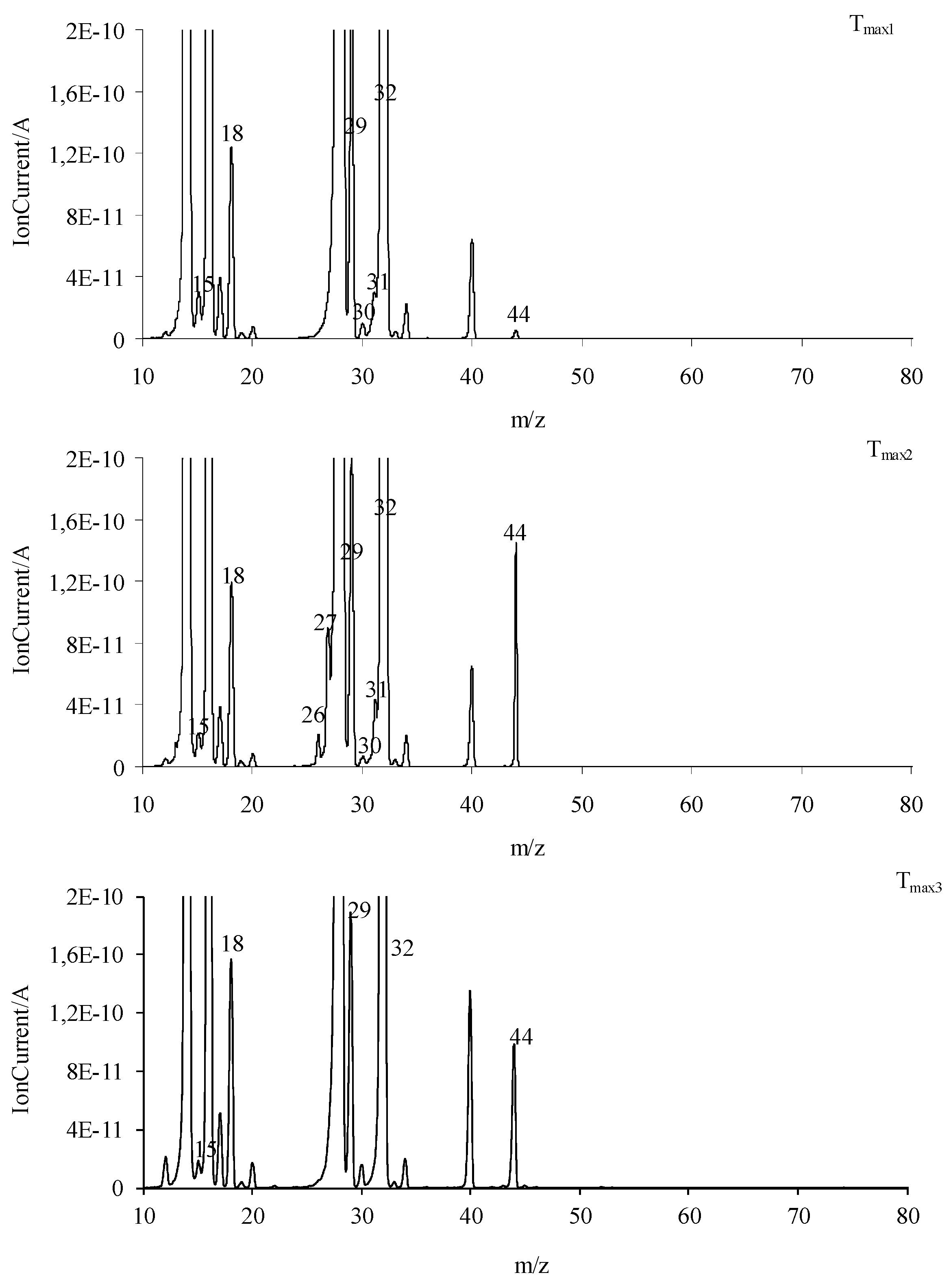
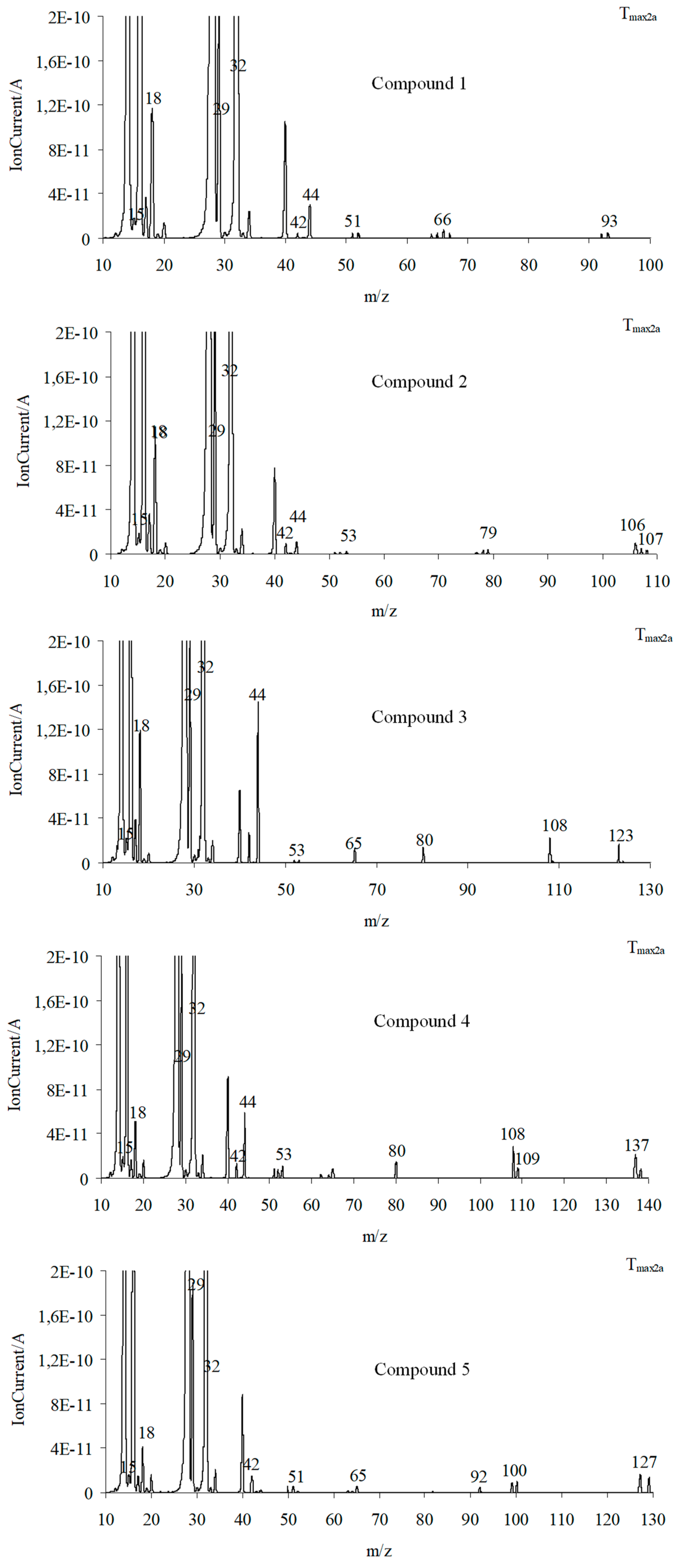
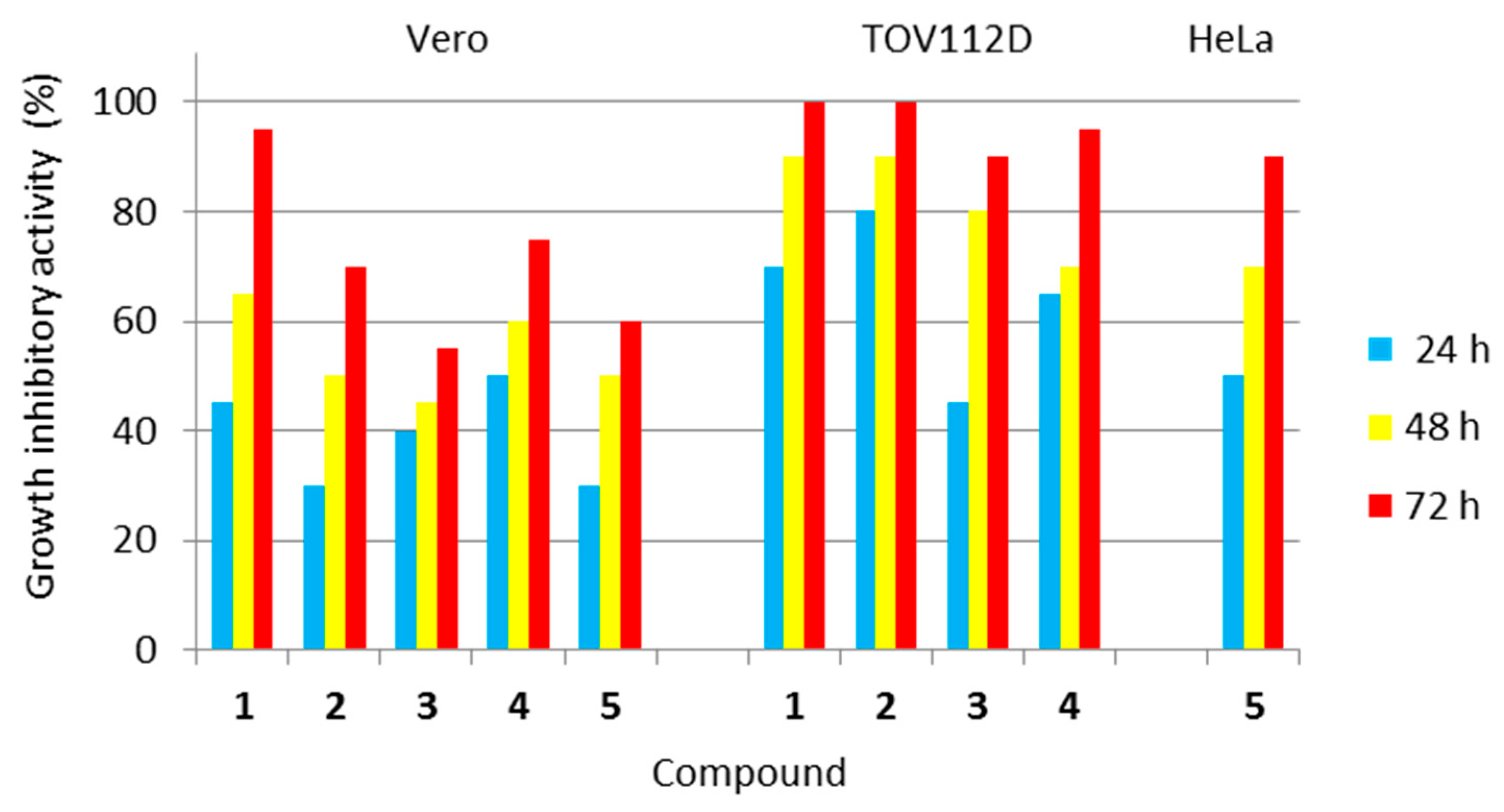
| Sample | Degradation Process | ||||||
|---|---|---|---|---|---|---|---|
| First Decomposition Stage | Second Degradation Stage | ||||||
| T5%/°C | Tmax1/°C | Δm1/% | Tmax2/°C | Tmax2a/°C | Δm2+ Δm2a/% | rm/% | |
| 1 | 200 | 206 | 11.0 | 289/305 | 378/414 | 69.6 | 19.4 |
| 2 | 208 | 209 | 9.5 | 287/313 | 377/413/439/495 | 65.4 | 25.1 |
| 3 | 206 | 209 | 9.0 | 289/317 | 379/414/499 | 66.9 | 24.1 |
| 4 | 203 | 209 | 9.7 | 290/319 | 377/414/444/501 | 65.7 | 24.6 |
| 5 | 201 | 207 | 9.8 | 278/326 | 378/407 | 65.9 | 24.3 |
| Sample | Degradation Process | |||||||
|---|---|---|---|---|---|---|---|---|
| First Decomposition Stage | Second Degradation Stage | Third Degradation Stage | ||||||
| T5%/°C | Tmax1/°C | Δm1/% | Tmax2/°C | Tmax2a/°C | Δm2+ Δm2a/% | Tmax3/°C | Δm3/% | |
| 1 | 195 | 202 | 11.7 | 281/325 | 373/386 | 56.3 | 625 | 32.0 |
| 2 | 197 | 203 | 8.9 | 282/321 | 349/381/490 | 50.4 | 594 | 40.7 |
| 3 | 194 | 196 | 9.5 | 273/326 | 372 | 38.3 | 579 | 52.2 |
| 4 | 195 | 203 | 8.7 | 284/334 | 410 | 49.1 | 578 | 42.2 |
| 5 | 191 | 200 | 10.6 | 275/338 | 398 | 49.2 | 574 | 40.2 |
| Compound | Bioactivity Score | |||||
|---|---|---|---|---|---|---|
| GPCR Ligand | Ion Channel Modulator | Enzyme Inhibitor | Protease Inhibitor | Kinase Inhibitor | Nuclear Receptor Ligand | |
| 1 | −0.17 | −0.24 | −0.34 | −0.46 | −0.70 | −0.81 |
| 2 | −0.20 | −0.31 | −0.39 | −0.48 | −0.72 | −0.80 |
| 3 | −0.18 | −0.28 | −0.36 | −0.44 | −0.67 | −0.74 |
| 4 | −0.23 | −0.30 | −0.39 | −0.46 | −0.71 | −0.70 |
| 5 | −0.16 | −0.24 | −0.37 | −0.47 | −0.69 | −0.79 |
Disclaimer/Publisher’s Note: The statements, opinions and data contained in all publications are solely those of the individual author(s) and contributor(s) and not of MDPI and/or the editor(s). MDPI and/or the editor(s) disclaim responsibility for any injury to people or property resulting from any ideas, methods, instructions or products referred to in the content. |
© 2023 by the authors. Licensee MDPI, Basel, Switzerland. This article is an open access article distributed under the terms and conditions of the Creative Commons Attribution (CC BY) license (https://creativecommons.org/licenses/by/4.0/).
Share and Cite
Worzakowska, M.; Sztanke, M.; Rzymowska, J.; Sztanke, K. Thermal Decomposition Path—Studied by the Simultaneous Thermogravimetry Coupled with Fourier Transform Infrared Spectroscopy and Quadrupole Mass Spectrometry—Of Imidazoline/Dimethyl Succinate Hybrids and Their Biological Characterization. Materials 2023, 16, 4638. https://doi.org/10.3390/ma16134638
Worzakowska M, Sztanke M, Rzymowska J, Sztanke K. Thermal Decomposition Path—Studied by the Simultaneous Thermogravimetry Coupled with Fourier Transform Infrared Spectroscopy and Quadrupole Mass Spectrometry—Of Imidazoline/Dimethyl Succinate Hybrids and Their Biological Characterization. Materials. 2023; 16(13):4638. https://doi.org/10.3390/ma16134638
Chicago/Turabian StyleWorzakowska, Marta, Małgorzata Sztanke, Jolanta Rzymowska, and Krzysztof Sztanke. 2023. "Thermal Decomposition Path—Studied by the Simultaneous Thermogravimetry Coupled with Fourier Transform Infrared Spectroscopy and Quadrupole Mass Spectrometry—Of Imidazoline/Dimethyl Succinate Hybrids and Their Biological Characterization" Materials 16, no. 13: 4638. https://doi.org/10.3390/ma16134638






